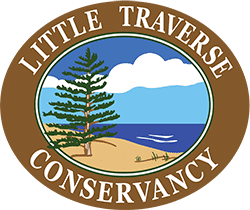Little Traverse Conservancy
Working Forest Reserves
A New Category of Lands
In 1986, the Conservancy accepted a 70-acre land donation, the Sims-Moffatt Preserve, that was enrolled in the Commercial Forest Program (CFP). CFP designation means it has and always will be actively managed for timber.
Over the years, a few other preserves – including the Offield Family Nature Preserve – have been accepted by Little Traverse Conservancy, coming to the organization with CFP designation. And in the fall of 2015, the Conservancy received the last of 17 parcels gifted to the organization and comprising a total of 1,200 acres; all enrolled in CFP. These gifts prompted us to create a new category of protected lands: Working Forest Reserves. Since then, new properties have been acquired and added to the Working Forest Reserves holdings.
While most Little Traverse Conservancy’s lands are traditional nature preserves with a mostly “hands-off” management philosophy, Working Forest Reserves forests will be carefully managed. To distinguish working reserve lands from conventional nature preserves, we will be using a different colored sign. Lands enrolled in the Commercial ForestProgram must have a forest management plan on file with the state, and the land must be managed for long-term timber production. The CFP also requires that the land be open to the public for hunting, fishing, and trapping. Removing a property from CFP involves paying the penalty.
As part of its forest management plan, selective logging will periodically occur on our CFP lands. This logging will appear sustainably following closely managed guidelines outlined by a professional forester with input from a wildlife biologist. While the initial appearance of the cuttings in reserve may seem unsightly, proper forest management will eventually enhance the property’s biodiversity and health by mimicking natural disturbance, suppressing forest diseases, and allowing native vegetation to thrive.
“We want the public to be assured that we are engaging in a comprehensive and conscientious process to ensure the long-term management of our working reserve lands,” said Kieran Fleming, the Conservancy’s Chief Operating Officer. “We have worked hard to ensure that our forestry practices are following best protocols for sustainable forestry, meaning that we are actively harvesting timber, but doing so in a way that maintains the integrity of the forest so that it will be here and healthy for future generations.”
Nationwide and statewide, the practice of forest management on Conservancy owned lands is not uncommon. And for many years, Little Traverse Conservancy has harvested pine plantations comprised of Scotch pine or other exotic species on nature preserves.
“For the Conservancy, this is about balance,” adds Fleming. “We have thousands of acres on which we let nature take its course. In 100 years, many of these will resemble a form of ‘old growth’ forest. And that’s great, but we also feel it is appropriate to own Working Forest Reserves that will have a more active management philosophy. This will enable us to diversify our forest habitats for the benefit of a wider variety of wildlife. All told, these are currently less than 10% of our holdings.”
In every Little Traverse Conservancy forest management plan, we include objectives resembling the following:
- Manage the property for public recreation.
- Manage the property for wildlife.
- Improve and maintain forest health.
- Sustainably generate revenue by harvesting timber.
Little Traverse Conservancy is working with volunteers and graduate students to study forest management’s impacts on these properties, hoping to gain insights into current topics such as the effects of climate change on forest resilience.
CFP Land at a Glance
Michigan’s commercial forest act program (CFP) provides a tax incentive to landowners who manage their property for long-term timber production. Landowners enrolled in the program pay reduced property taxes, and the state of Michigan pays an additional amount to counties where the land is enlisted to help make up for the tax reduction.
The Commercial Forest Act requires that landowners manage commercial timber production and must have a written management plan. It also requires that landowners must permit foot access to allow the general public the privilege of hunting, fishing, or trapping on commercial forest land. While permission to hunt is not required on CFP lands, we ask that you complete the permission form as a courtesy for Little Traverse Conservancy records. More information can be found at the Michigan Department of Natural Resources website.
